|
Welcome Back, Doc!
Doc Green is back from a short sabbatical talking with greenhouse plants across the country and he has brought back the following Spectrum Technologies Greenhouse Grower Products: soil EC (nutrition) and light measurement information to share with you.

Never miss our newsletter again! Your plants are trying to talk to you, make sure you don’t miss the message! “If Plants Could Talk” is full of industry specific information and tips to help you make profitable decisions.
This Month's Topic: Greenhouse Plants and Nutrients
Many greenhouse growers encounter plant nutrition problems that affect plant quality and profitability. That’s because their focus has been reactive instead of proactive…to have a plan in place with the right diagnostic tool to prevent problems is a critical step for Greenhouse productivity and success.
Why EC Measurement?
The EC of the soil solution, irrigation water or fertilizer solution is an important parameter affecting the root zone environment. Any of these factors can have a significant effect on plant growth and quality. The easiest way to monitor salinity is by measuring the electrical conductivity (EC). EC is strongly correlated to the nutrition of the soil solution. EC measurement is also affected by temperature and, to a lesser degree, by soil moisture content. Typically, measuring nutrition levels has been cumbersome, time consuming and could possibly damage the plants. Now there is a better, more accurate technique and one that growers can easily adopt. Spectrum’s new WaterScout® SMEC 300 Soil Moisture/EC/Temperature Sensor easily measures plant nutrition deficiencies resulting in more accuracy.

Track water, salts, and soil temperature: all with a single sensor!
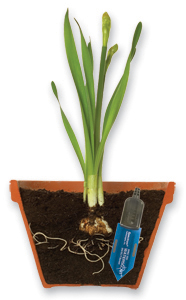 Root zone salinity for Greenhouse plants is a critical element for healthy plant growth. Irrigation, fertilizers, and crop demand all impact salt concentrations. High levels can damage the plant: low levels can lead to nutrient deficiencies. Therefore, EC measurement is a very important practice to measure the nutrient health of plants. Root zone salinity for Greenhouse plants is a critical element for healthy plant growth. Irrigation, fertilizers, and crop demand all impact salt concentrations. High levels can damage the plant: low levels can lead to nutrient deficiencies. Therefore, EC measurement is a very important practice to measure the nutrient health of plants.
The SMEC 300 measures EC with a pair of carbon ink electrodes which provide a large contact surface with the soil solution. Temperature is measured with a thermistor potted in the sensor molding. The SMEC 300 is designed to be compatible with the WatchDog® data loggers and weather stations as well as the FieldScout® soil sensor reader. SpecWare™ software enables you to view your data in graphical and tabular form as well as run reports customized to your application.
Product Features:
-
Capacitance-type soil moisture sensor
-
Carbon ink electrodes provide large measuring surface for EC
-
Easy, 1-step EC calibration process
-
Can be read with the FieldScout Soil Sensor Reader (Item 6466) or WatchDog 1000 and 2000 Series Stations
-
Connect up to 2 sensors per station (depending on model)

The EC sensor can be calibrated with a simple, 1-step process. Use the available hand-held reader to take fast and accurate spot readings. Or you may choose to bury the sensor and track soil moisture and soil EC changes over time with the WatchDog data-logging weather station.
The sensors should be located in the effective root zone and at locations that will give a representative picture of the salinity and soil water status of the area being measured. For greenhouse applications, select one or more representative containers. Selecting a site which receives the least amount of water from the irrigation system will tell you when that area becomes critically dry and is in need of attention. Sites that have the greatest fluctuation in soil moisture will exhibit the greatest level of EC variability as well.
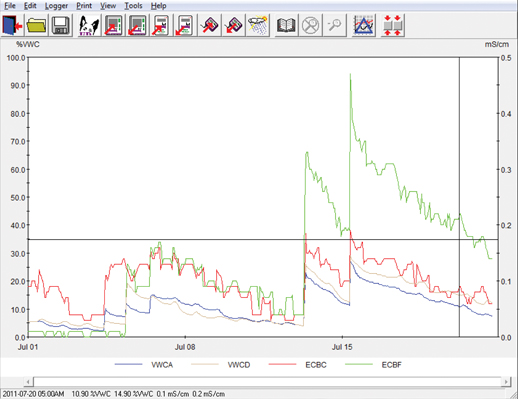
You can collect data and log results when the WaterScout SMEC 300 Sensor is connected to a WatchDog Station.
Why Light Measurement?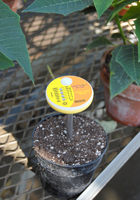
If photons were raindrops, light meters would show the intensity of a rainstorm. A five-minute rainstorm may look impressive, but often provides less water than an all-day drizzle. Just as cumulative rainfall is measured with a rain gauge, the cumulative quantity of light is measured using a DLI light meter. The daily total of quantum light is called the Daily Light Integral, or DLI, and is measured in units of mol/m2day. DLI quantifies the light available to plants to perform photosynthesis.
Each type of plant can have a different DLI range for optimal growth. DLI is directly correlated with plant quality, and a minimum amount of light is required for marketable plants. Measuring DLI over a growing season and comparing it to results can help a grower decide not only which varieties work best for his or her location, but also which variables to control within the Greenhouse.

Product Features:
-
Increase plant growth and quality
-
Compare light between multiple locations, simultaneously
-
Simple, one button operation
-
Two light meters in one - Measures intensity and calculates DLI
-
An affordable, first step in measuring light
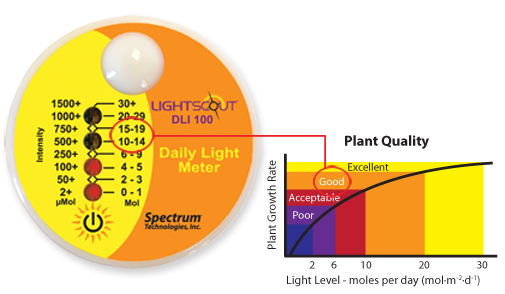
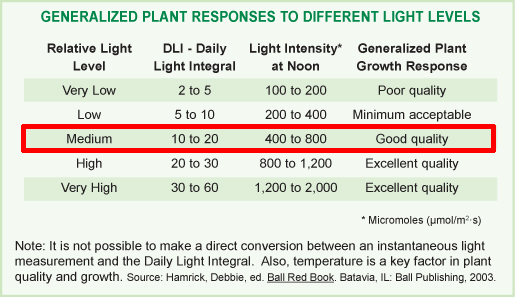
This year marks our 25th year of doing business!
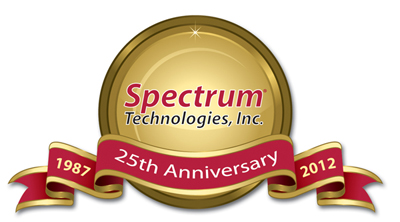
We want to thank the many researchers and customers who have contributed to our success. We look forward to serving and working with you on our continued goal to be the partner you can count on for affordable Plant Measurement Technology.
|